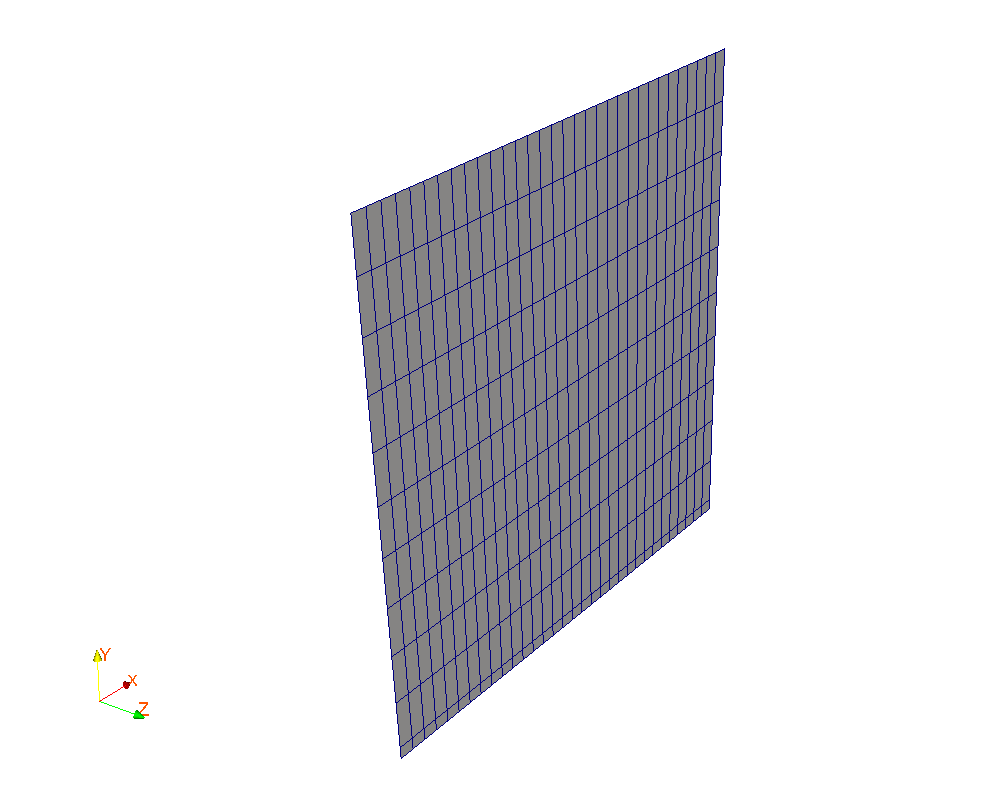10. M modeling#
10.1. Characteristics of modeling#
The modeling is D_ PLAN, the frame is represented by a solid of almost rigid material. Two calculations are performed with different linear solvers.
10.2. Characteristics of the mesh#

Number of knots: 429
Number of meshes and types: 320 QUAD4 for the plate and 32 QUAD4 for the frame.
10.3. Tested sizes and results#
First calculation (controlled geometric update, formulation “CONTINUE”, solver “MULT_FRONT”)
Identification |
Reference type |
Reference value |
Tolerance |
\(\mathit{JEU}\) at point \(R\) instant \(1.0\) |
“NON_REGRESSION” |
0 |
1,0E-12 |
\(\mathit{CONT}\) at the point \(R\) instant \(1.0\) |
“NON_REGRESSION” |
1 |
1.0E-5% |
\(\mathit{RN}\) at the point \(R\) instant \(1.0\) |
“NON_REGRESSION” |
1.049E+5 |
1.0E-5% |
\(\mathit{DX}\) at the point \(A\) instant \(1.0\) |
“SOURCE_EXTERNE” |
2.86E-5 |
5.0% |
\(\mathit{DX}\) at point \(B\) instant \(1.0\) |
“SOURCE_EXTERNE” |
2.72E-5 |
5.0% |
\(\mathit{DX}\) at the point \(C\) instant \(1.0\) |
“SOURCE_EXTERNE” |
2.28E-5 |
5.0% |
\(\mathit{DX}\) at point \(D\) instant \(1.0\) |
“SOURCE_EXTERNE” |
1.98E-5 |
5.0% |
\(\mathit{DX}\) at the point \(E\) instant \(1.0\) |
“SOURCE_EXTERNE” |
1,5E-5 |
5,0% |
Second calculation (controlled geometric update, formulation “CONTINUE”, solver “LDLT”)
Identification |
Reference type |
Reference value |
Tolerance |
\(\mathit{DX}\) at the point \(A\) instant \(1.0\) |
“SOURCE_EXTERNE” |
2.86E-5 |
5.0% |
\(\mathit{DX}\) at point \(B\) instant \(1.0\) |
“SOURCE_EXTERNE” |
2.72E-5 |
5.0% |
\(\mathit{DX}\) at the point \(C\) instant \(1.0\) |
“SOURCE_EXTERNE” |
2.28E-5 |
5.0% |
\(\mathit{DX}\) at point \(D\) instant \(1.0\) |
“SOURCE_EXTERNE” |
1.98E-5 |
5.0% |
\(\mathit{DX}\) at the point \(E\) instant \(1.0\) |
“SOURCE_EXTERNE” |
1,5E-5 |
5,0% |
10.4. notes#
The results obtained are close to the external source to within 5% (code mean). The linear solver has no influence on the results.
The continuous formulation gives results identical to the discrete formulation.
The modeling of the frame by a material that is very stiff in front of the material of the plate gives results equivalent to the case of the rigid frame whose only edge is represented.
The 3D problem gives results identical to 2D following the blocking of the degrees of freedom following \(\mathit{DZ}\).